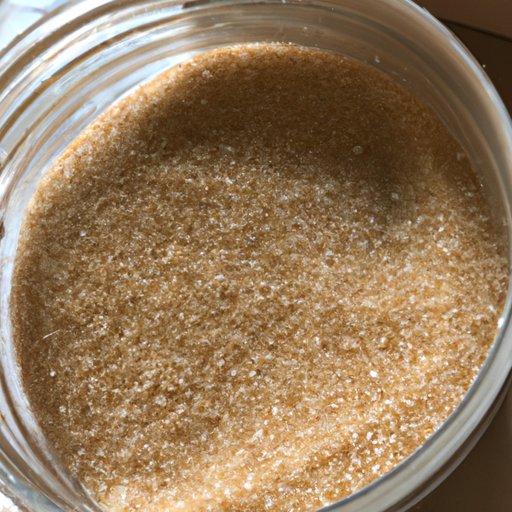I. Introduction
Brown sugar is a common ingredient in a variety of baking and cooking recipes. Unfortunately, it is not always easy to find brown sugar on hand at home. It is, however, surprisingly easy to make at home. This article will provide you with a step-by-step guide on how to make brown sugar at home so that you never have to go without.
II. What is Brown Sugar and Why is it Used in Baking?
Brown sugar is a sweetener that is commonly used in baking and cooking. Brown sugar is essentially granulated white sugar that has molasses added to it. The molasses gives brown sugar its signature texture and flavor.
Unlike white granulated sugar, brown sugar has a softer texture and a rich, caramel-like flavor. It is ideal for adding flavor to cookies, cakes, and other baked goods.
III. How to Make Brown Sugar at Home
If you want to make brown sugar at home, all you need is granulated white sugar and molasses. Follow these simple steps:
- Pour 1 cup of granulated white sugar into a mixing bowl.
- Add 1 tablespoon of molasses for light brown sugar. Add 2 tablespoons of molasses for dark brown sugar.
- Use a fork to mix the sugar and molasses together until the mixture is thoroughly combined.
- Store the homemade brown sugar in an airtight container until ready to use.
When making brown sugar at home, it is important to note that the final product will not be as fine as store-bought brown sugar. However, this does not affect the taste or quality of the brown sugar in any way.
If you are looking for alternative sweeteners for your brown sugar, you can use coconut sugar or honey. Keep in mind that the flavor and texture may differ from traditional brown sugar.
IV. Brown Sugar Recipes
Making brown sugar at home opens up a world of new recipe possibilities. Here is a tested recipe that calls for brown sugar:
Homemade BBQ Sauce
- 1 cup ketchup
- ¼ cup apple cider vinegar
- ¼ cup brown sugar
- 2 tablespoons Worcestershire sauce
- 1 tablespoon smoked paprika
- 1 teaspoon garlic powder
- Salt and pepper to taste
To incorporate your homemade brown sugar into this recipe, substitute the store-bought brown sugar with your homemade brown sugar in equal measurements. Mix all ingredients together in a saucepan and simmer for 10-15 minutes until thickened.
You can also experiment with different variations of brown sugar, such as using dark brown sugar instead of light brown sugar, to change the flavor profile of this recipe.
V. Light vs. Dark Brown Sugar
There are two types of brown sugar: light and dark. Light brown sugar has a lower molasses content than dark brown sugar, giving it a slightly lighter color and milder flavor. For recipes that require brown sugar but don’t specify whether it should be light or dark, it is usually safe to use light brown sugar.
For recipes that require a stronger molasses flavor, such as gingerbread or brownies, dark brown sugar is the better choice. If you prefer one type of brown sugar over the other, you can adjust the ratio of sugar to molasses to achieve the desired color and flavor.
VI. Expert Tips and Tricks
To get some insights from professional bakers and chefs on using brown sugar, we interviewed several experts on their favorite recipes that feature brown sugar:
Barbara, Pastry Chef at a Five-Star Restaurant
“My go-to brown sugar recipe is for a bourbon pecan tart. I use dark brown sugar for this recipe to get a richer, more caramel flavor. I also make my own brown sugar at home because it gives me more control over the flavor and texture of the tart.”
Steve, Head Baker at a Specialty Bakery
“I use brown sugar in my oatmeal raisin cookies. The combination of brown sugar and cinnamon gives the cookies a warm, comforting flavor. I prefer using light brown sugar for this recipe because it creates a more tender cookie.”
When using brown sugar in baking and cooking, it is important to measure it accurately. Brown sugar has a tendency to clump together and can make it difficult to measure accurately. Use a fork or a sifter to break up any clumps before measuring.
VII. The History of Brown Sugar
Brown sugar has been used as a sweetener for centuries. The first recorded use of brown sugar dates back to 9th-century China. It was not until the 17th century, however, that brown sugar became widely available in Europe.
Today, brown sugar is used in a variety of culinary traditions around the world. Making your own brown sugar at home can be part of a larger trend of homemade and artisanal cooking that is growing in popularity.
VIII. Personal Experience
Making brown sugar at home is not only easy but also empowering. I started making my own brown sugar after realizing that I was constantly running out of it. Now, I have complete control over the flavor and texture of the brown sugar that I use in my baking and cooking recipes. Plus, it’s a great way to save money and reduce waste.
IX. Conclusion
If you’ve ever found yourself without brown sugar when you need it, you now know how easy it is to make your own. With the step-by-step guide and tips and tricks in this article, you can make brown sugar that is perfect for your favorite recipes. Experiment with different ratios of sugar and molasses to find the perfect flavor and color for your needs.
